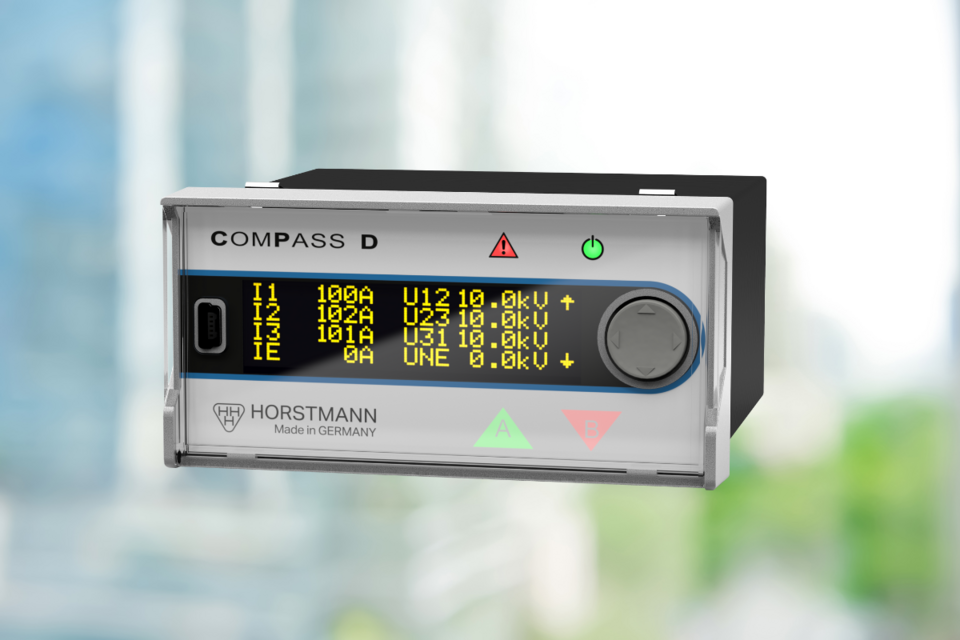On the way to the smart grid

ComPass D - with IEC 60870-5-104 protocol - brings transparency to the power grid
With fault direction indicators from Horstmann, energy suppliers monitor power grids in real-time.
Electricity for thousands of households and the management of e-charging stations, photovoltaic systems, and electricity storage: energy suppliers and grid operators are faced with the challenge of ensuring the security of supply with increasing electricity consumption, fluctuating feed-in and constantly changing load flow direction in the power grid. The directional short-circuit and earth fault indicator ComPass D from Horstmann provides real-time information about the grid status and can also contribute to overcoming the growing challenges in the power grid.
Thousands of kilometres of power grid
The integration of more and more electricity consumers, such as e-charging stations and heat pumps, and more and more different feed-in points, such as photovoltaic systems and wind turbines, is increasing the load on the electricity grid for energy suppliers and thus the risk of failure. Smart grids with automated monitoring are being expanded to make the grid more transparent, detect faults earlier and minimise downtimes. Horstmann's ComPass D fault direction indicator is being installed in the load stations of the medium-voltage grid for this purpose.
More insight in the power grid
Until now, troubleshooting in the event of a fault was often time-consuming and resembled flying blind in the grid. This frequently required short-circuiting, putting strain on cables and switches. With the proven ComPass D, troubleshooting is now much easier and faster. Mounted in the substations of the medium-voltage grid, it monitors the load on the power grid and provides the data on short-circuit and earth fault indications for communication to the control center. There, the employees can see on the monitor in real time between which substations the fault is located and then dispatch the grid technicians to solve the fault. On-site, ComPass D also clearly indicates the direction of the fault using two directional arrow LEDs.
Simple connection via 104 protocol
Data is transmitted from ComPass D to the control center via the IEC 60870-5-104 protocol. Remote maintenance and parameterisation of the ComPass D are then carried out remotely via the ScadaDataConfigurator. The ComPass D can also be parameterised on-site via USB cable using a laptop or tablet. Not only is the short-circuit and earth fault data transmitted to the control centre, but also high precision measured values for current, voltage and power. Limit values can also be defined for all measured values. If these are exceeded or not reached, the control center receives an alarm message and can act quickly to prevent grid failures in advance.
Further advantages of the ComPass D directional short-circuit and earth fault indicator
ComPass D is equipped with two directional arrow LEDs (red/green) and a high-contrast OLED display. It can perform high-precision measurements of current and voltage. It also measures the load flow direction, power factor, power, energy, temperature, and frequency. ComPass D is suitable for all grid types and neutral point treatments and can be connected to capacitive and resistive sensors. For customers, this means immediate detection of limit value violations and fault direction, as well as the constant availability of measured values in real time. In addition, the ComPass D directional short-circuit and earth fault indicator enables multichannel communication via the Ethernet port. This means that devices can be connected to the control room at the same time and parameterised or maintained in parallel.
Grid made fit for the future
After installing the ComPass D, the response times for faults are significantly reduced. The digital fault direction indicator is also an investment in the future: ComPass D uses the collected data to ensure greater transparency in the medium-voltage grid. This turns it into a smart grid in which we can automatically intercept power peaks and control grid efficiency much better than before.
Summary
The ComPass D digital fault direction indicator from Horstmann is used to monitor power grids in real time. Energy suppliers and grid operators use it to better manage the increasing load on the power grid caused by e.g. e-charging stations, heat pumps and renewable energies. ComPass D enables efficient fault detection, which minimises downtimes. Data is transmitted via the IEC 60870-5-104 protocol. The user benefits from precise measured values for current, voltage and power as well as the option of defining limit values and receiving alarm messages in the event of violations. The ComPass D fault direction indicators contribute to transparency in the medium-voltage grid and enable effective control of the power grid to make it fit for the future.
For more information about ComPass D please click here.